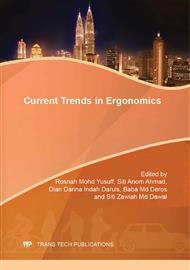[1]
Bosert, J. L, 1991, Quality Functional Deployment: A Practitioner's Approach. ASQC Quaility Press, New York.
Google Scholar
[2]
Cho, H. and Fiorito, S.S., 2010, Self-Service Technology in Retailing, Emerging Issues in Management, 43-55.
Google Scholar
[3]
Development Core Team, 2008, A language and environment for statistical computing. R Foundation for Statistical Computing, Vienna, Austria. [online accessed on 13 January 2013] URL: http: /www. R-project. org.
Google Scholar
[4]
Dumas, J. S. and Janice C. R., 1993, A practical guide to usability testing. Norwood, N.J.: Ablex. International Organization for Standardization.
Google Scholar
[5]
Axup, J and Stephen V., 2005, Formative Research Methods For The Extremely Mobile: Supporting Community, University of Queensland, Australia.
Google Scholar
[6]
Karat, J., & Karat, C. M., 2003, The evolution of user-centered focus in the human-computer interaction field. IBM Systems Journal Archive, 42, 532–541.
DOI: 10.1147/sj.424.0532
Google Scholar
[7]
Landauer, T. K., 1995, The trouble with computers: Usefulness, usability and productivity, Cambridge, Mass MIT Pr.
Google Scholar
[8]
Lazar, J. and Preece, 2002, Social Considerations in Online Communities: Usability, Sociability and Success Factors, in H. van Oostendorp (ed. ) Cognition in the Digital World. NJ: Lawrence Erlbaum Associates Inc.
DOI: 10.4324/9781410607072-12
Google Scholar
[9]
Lederer and Prassad, A. L. P. J., 1992, Nine Management Guidelines for Better cost Estimating. Communications of the ACM, 35(2), 51-59.
DOI: 10.1145/129630.129632
Google Scholar
[10]
Nielsen, J., 1993, Usability Engineering. Boston: Academic Press.
Google Scholar
[11]
Preece, J., 1994, Human-Computer Interaction, Addison-Wesle.
Google Scholar
[12]
Pressman, R. S., 1992, Software engineering: A practitioner's approach. New York: McGraw Hill.
Google Scholar
[13]
Ridwan., 2003, Skala Pengukuran Variabel-variabel Penelitian, Bandung: Alfabeta.
Google Scholar
[14]
Rubin, J and Chisnell D., 2008, Handbook of Usability Testing, Canada: Wiley.
Google Scholar
[15]
Sugiyono, 2005, Statistik Untuk Penelitian. Bandung: Alfabeta.
Google Scholar
[16]
Shackel, B., 1990, Human factors and usability. In J. Preece and L. Keller (eds. ), Human-Computer Interaction: Selected Readings. London: Prentice Hall, 27-41.
Google Scholar


